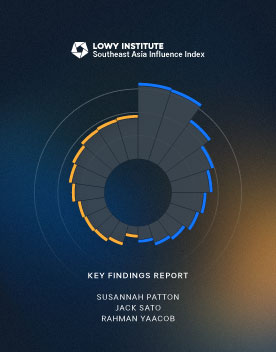Southeast Asia Influence Index
Southeast Asia is one of the most geopolitically contested regions of the world. It engages the interest of superpowers China and the United States, Indo‑Pacific powers such as Australia, India, Japan, and South Korea, and those from further afield, including European countries. The Southeast Asia Influence Index provides the first comprehensive analysis of the relative importance of these partners for each Southeast Asian country across five dimensions of influence, as well as analysis of the important relationships between Southeast Asian countries themselves.
China is everywhere in Southeast Asia
Since at least 2017, China has been the most influential power overall in Southeast Asia, and the leading partner for most countries. Beijing is the largest trading partner for almost all countries, and an increasingly important source of private investment to the region. Its primary strength lies in economic relationships, supported by consistent diplomacy across Southeast Asia: China is the top international destination for Southeast Asian leaders and foreign ministers. However, it lacks extensive defence networks with most countries.
America’s two faces
The United States is the second-most influential partner for the region, but its influence varies wildly. In the Philippines and Singapore, it is an essential defence and security partner, with a highly relevant and visible presence. But in much of the region, especially the smaller countries of mainland Southeast Asia such as Cambodia and Laos, its presence is more peripheral. The global policies of the Trump administration on tariffs, aid cuts, and international education are only likely to result in a growing disconnect between the United States and these countries.
Southeast Asia’s collective dynamic
Collectively, Southeast Asian countries are more important to each other than any external partner. Intra-regional dynamics, especially relations between direct neighbours, often matter more than competition among external powers. Two clusters of neighbourhood relationships reflect close economic, migration, and cultural connections — one in Mekong Southeast Asia, comprising Vietnam, Laos, Cambodia, and Thailand; and the other in maritime Southeast Asia, comprising Indonesia, Singapore, Malaysia, and Brunei. By contrast, the Philippines is more oriented to partnerships with countries from outside the region.
Japan leads the Indo‑Pacific powers
Beyond the United States and China, four Indo-Pacific middle powers — Australia, India, Japan, and South Korea — exercise influence in Southeast Asia. But only Japan has a multidimensional presence across the entire region. While it has lost relative economic influence to China over recent years, it has become an increasingly important security partner to the region. Australia and South Korea have influence that is concentrated in economic relationships and defence networks respectively. India has a well-developed architecture of engagement, but practical follow-through sometimes lags the pace of announced initiatives.
Long-distance relationships
Southeast Asia’s next tier of partners from outside the region — Canada, France, Russia, and the United Kingdom — are not central players but with targeted strategies can exercise influence in niche areas. The United Kingdom is important for its continued cultural influence and engagement with former Commonwealth countries. Russia’s footholds include its defence exports to mainland Southeast Asia and its dissemination of information through new and old media platforms, including Sputnik radio.
Diversification with dependence
No Southeast Asian country is within the uncontested sphere of influence of a single external partner. For example, five different external partners rank first for at least one sub-measure of influence in Brunei, Indonesia, Malaysia, Myanmar, and Vietnam. Even Cambodia and Laos have four different partners who each lead on at least one sub-measure of influence. Yet several countries are highly exposed to China in specific sectors such as tourism, investment, or trade. General diversification strategies, for example, signing new strategic partnership agreements, are unlikely to meaningfully address these areas of over-reliance.

Explore more analysis
The Southeast Asia Influence Index Key Findings Report includes in-depth analysis on the region’s patterns of influence. Read the report for a fuller picture of Southeast Asia’s complex and dynamic geopolitics.